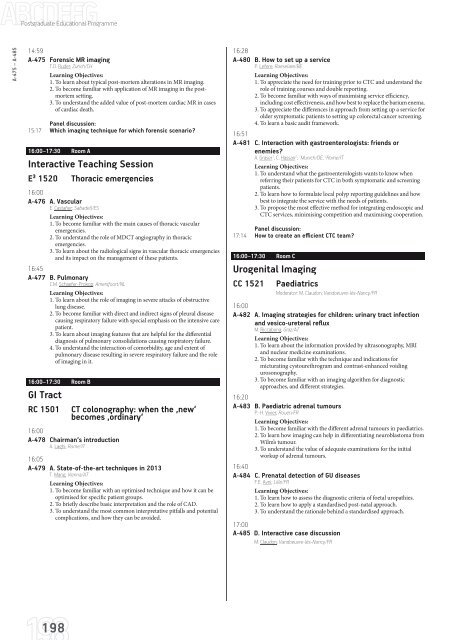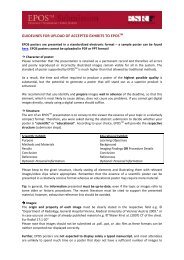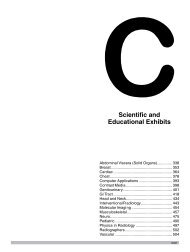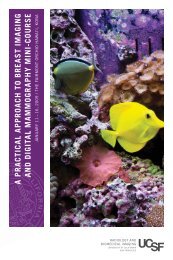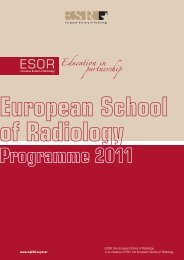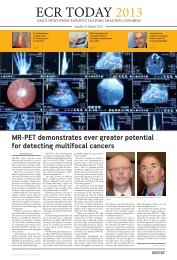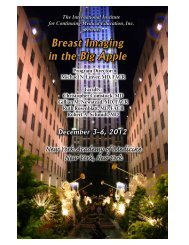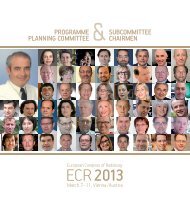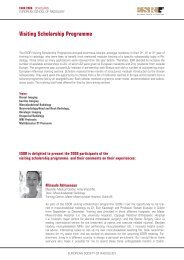ECR 2013 â Final Programme - myESR.org
ECR 2013 â Final Programme - myESR.org
ECR 2013 â Final Programme - myESR.org
- No tags were found...
You also want an ePaper? Increase the reach of your titles
YUMPU automatically turns print PDFs into web optimized ePapers that Google loves.
Postgraduate Educational <strong>Programme</strong>A-475 – A-48514:59A-475 Forensic MR imagingT.D. Ruder; Zurich/CHLearning Objectives:1. To learn about typical post-mortem alterations in MR imaging.2. To become familiar with application of MR imaging in the postmortemsetting.3. To understand the added value of post-mortem cardiac MR in casesof cardiac death.Panel discussion:15:17 Which imaging technique for which forensic scenario?16:00–17:30 Room AInteractive Teaching SessionE³ 1520 Thoracic emergencies16:00A-476 A. VascularE. Castañer; Sabadell/ESLearning Objectives:1. To become familiar with the main causes of thoracic vascularemergencies.2. To understand the role of MDCT angiography in thoracicemergencies.3. To learn about the radiological signs in vascular thoracic emergenciesand its impact on the management of these patients.16:45A-477 B. PulmonaryC.M. Schaefer-Prokop; Amersfoort/NLLearning Objectives:1. To learn about the role of imaging in severe attacks of obstructivelung disease.2. To become familiar with direct and indirect signs of pleural diseasecausing respiratory failure with special emphasis on the intensive carepatient.3. To learn about imaging features that are helpful for the differentialdiagnosis of pulmonary consolidations causing respiratory failure.4. To understand the interaction of comorbidity, age and extent ofpulmonary disease resulting in severe respiratory failure and the roleof imaging in it.16:00–17:30 Room BGI TractRC 1501CT colonography: when the ‚new‘becomes ‚ordinary‘16:00A-478 Chairman‘s introductionA. Laghi; Rome/IT16:05A-479 A. State-of-the-art techniques in <strong>2013</strong>T. Mang; Vienna/ATLearning Objectives:1. To become familiar with an optimised technique and how it can beoptimised for specific patient groups.2. To briefly describe basic interpretation and the role of CAD.3. To understand the most common interpretative pitfalls and potentialcomplications, and how they can be avoided.16:28A-480 B. How to set up a serviceP. Lefere; Roeselare/BELearning Objectives:1. To appreciate the need for training prior to CTC and understand therole of training courses and double reporting.2. To become familiar with ways of maximising service efficiency,including cost effectiveness, and how best to replace the barium enema.3. To appreciate the differences in approach from setting up a service forolder symptomatic patients to setting up colorectal cancer screening.4. To learn a basic audit framework.16:51A-481 C. Interaction with gastroenterologists: friends orenemies?A. Graser 1 , C. Hassan 2 ; 1 Munich/DE, 2 Rome/ITLearning Objectives:1. To understand what the gastroenterologists wants to know whenreferring their patients for CTC in both symptomatic and screeningpatients.2. To learn how to formulate local polyp reporting guidelines and howbest to integrate the service with the needs of patients.3. To propose the most effective method for integrating endoscopic andCTC services, minimising competition and maximising cooperation.Panel discussion:17:14 How to create an efficient CTC team?16:00–17:30 Room CUrogenital ImagingCC 1521PaediatricsModerator: M. Claudon; Vandoeuvre-lès-Nancy/FR16:00A-482 A. Imaging strategies for children: urinary tract infectionand vesico-ureteral refluxM. Riccabona; Graz/ATLearning Objectives:1. To learn about the information provided by ultrasonography, MRIand nuclear medicine examinations.2. To become familiar with the technique and indications formicturating cystourethrogram and contrast-enhanced voidingurosonography.3. To become familiar with an imaging algorithm for diagnosticapproaches, and different strategies.16:20A-483 B. Paediatric adrenal tumoursP.-H. Vivier; Rouen/FRLearning Objectives:1. To become familiar with the different adrenal tumours in paediatrics.2. To learn how imaging can help in differentiating neuroblastoma fromWilm’s tumour.3. To understand the value of adequate examinations for the initialworkup of adrenal tumours.16:40A-484 C. Prenatal detection of GU diseasesF.E. Avni; Lille/FRLearning Objectives:1. To learn how to assess the diagnostic criteria of foetal uropathies.2. To learn how to apply a standardised post-natal approach.3. To understand the rationale behind a standardised approach.17:00A-485 D. Interactive case discussionM. Claudon; Vandoeuvre-lès-Nancy/FR198


